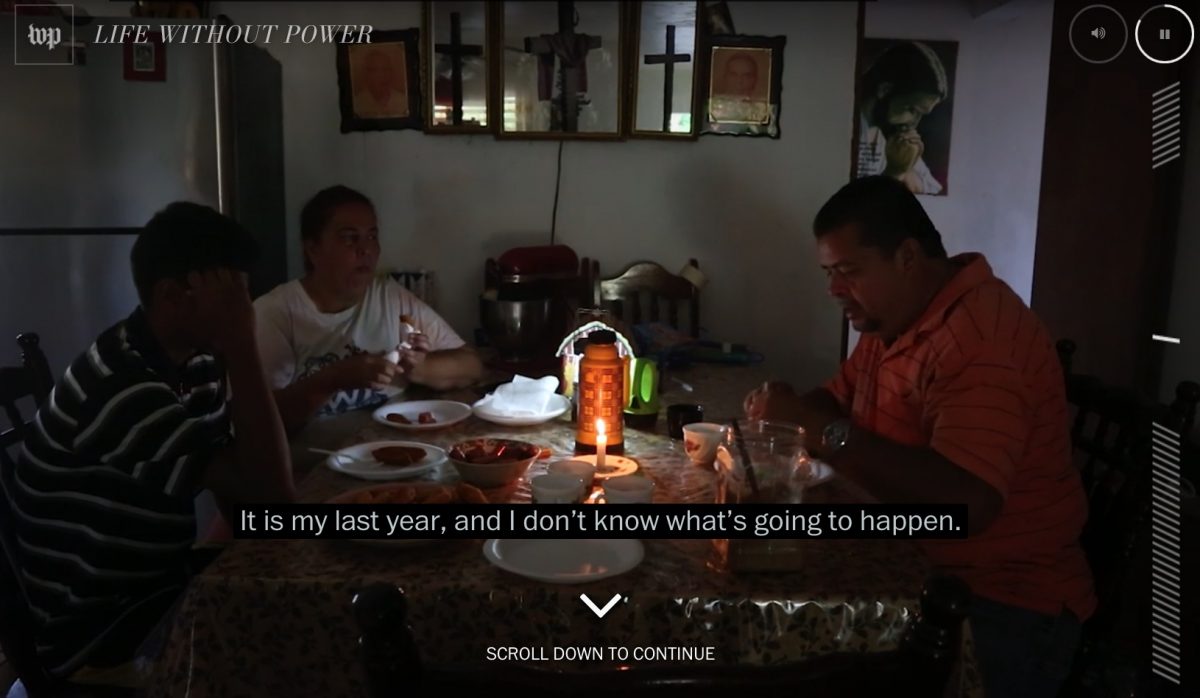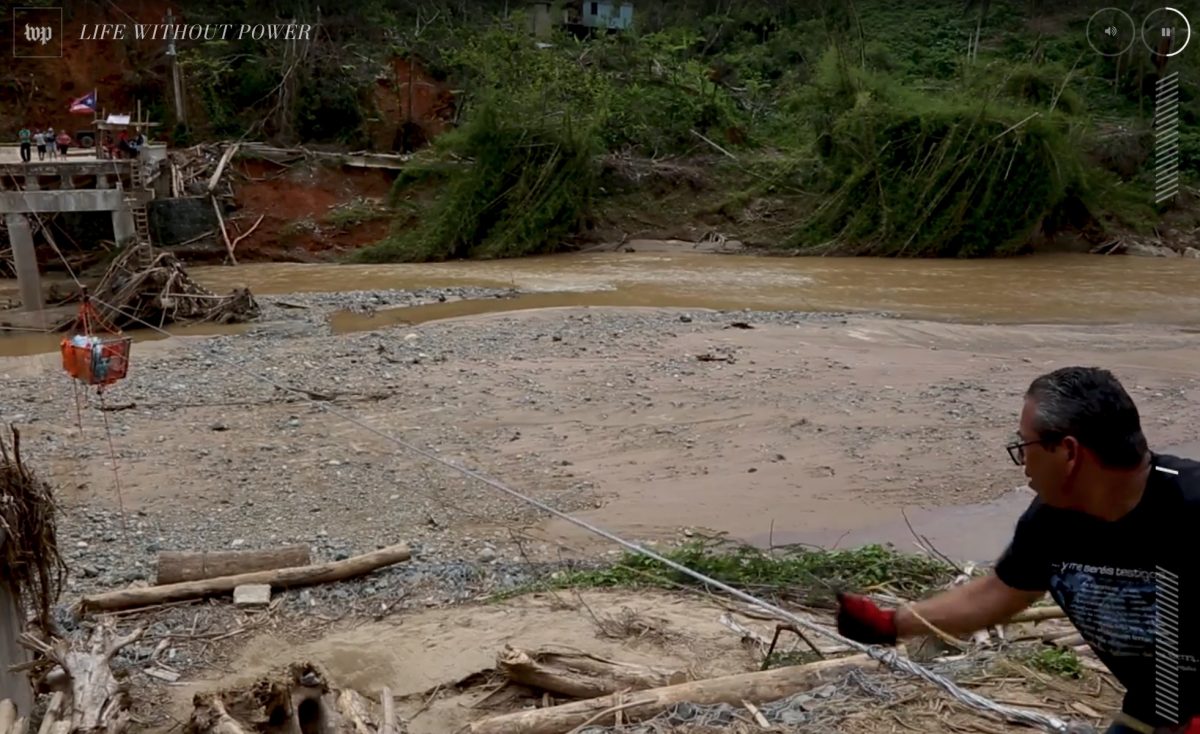How The Washington Post offered readers an immersive look at Puerto Rico without power
A blue pickup truck drives past Maria Ortiz Viruet as she walks down a paved road, followed by two small black dogs. The scene’s palm trees and mountains might lead viewers to believe nothing is out of the ordinary on this day in Puerto Rico. But Viruet, a public school teacher, has no students to teach, and her 18-year-old son is unable to finish his last semester of high school. Meanwhile, Aixa Jimenez, a home hospice nurse, struggles to care for her patients who require oxygen. Elsewhere on the island, Maria and Roberto Rivera keep their street food business open, seeking normalcy in the chaos.
The storm, which made landfall on September 20, left the entire territory without power in what has become the largest blackout in United States history. Now, months after Hurricane Maria devastated the island, just 65 percent of Puerto Rico has seen electricity restored. And those estimates vary. What’s certain is that restoring power fully will take many more months.
The Washington Post’s Arelis Hernández, Whitney Leaming and Zoeann Murphy traveled to Puerto Rico twice to explore Yabucoa, the town where Maria made landfall. Their work resulted in “Sin Luz: Life Without Power,” which was published in both English and Spanish on Dec. 14 without paywall restrictions. The project boasted a sixteen-person team that was responsible for reporting, designing and implementing strategies to display the videos, text and 3D maps in a full-screen experience.
Hernández and Post designers Seth Blanchard, Emily Yount and Armand Emamdjomeh spoke to Storybench about the harsh reality Puerto Rico is facing and how their presentation allows viewers to immerse themselves visually and mentally in the disaster.

Hatching the story
The first obstacle for Hernández and videographers Leaming and Murphy came as they tried to travel to the island – Leaming and Murphy were able to secure spots on military transports through the National Guard, while Hernández flew commercially from Orlando.
“Things were a little easier than what I expected, but it was chaos,” Hernández said. “You land in the airport, the power’s out, the lights are out. There are a few things that are working on generator power so you just get your luggage and try to figure it out step-by-step.”
Blanchard visited the island later to shoot drone photography that the design team would use to reconstruct major landmarks in the community.
“It was very shocking,” he remarked. “It’s winter here, and in D.C. there aren’t really leaves on the trees in November, so going down and not seeing leaves on the trees wasn’t initially surprising, but as soon as you thought about it you realized that it was surprising and all those trees should be totally covered in leaves, they should be green.”
Puerto Rico has been without power for 100 days. In this immersive story, The Post's @arelisrhdz @ZoeannMurphy @wleaming document what life is like now for people on the island. https://t.co/mx9tztt5b2
— Washington Post PR (@WashPostPR) December 29, 2017
A fellow Post reporter had traveled to the island and secured a hotel suite, where the trio stayed for a portion of their journey before bouncing between Airbnb homes and other hotels. They were also able to borrow a rental car, in which they traveled meticulously-planned routes that featured calculated stops at gas stations. The reporters often spent full days without communicating with editors due to a lack of Wifi or cellphone service, opting to update those on the mainland at the end of the day.
The idea for the story to zero in on daily life without electricity came from this initial three-week journey.
“It’s one thing that we cover the storm itself and all the damage it did, but this issue with power sort of continues,” Hernández said. “Especially with estimates showing they wouldn’t get power back for six to nine months, which is unheard of.”
Hernández knew the mayor of Yabucoa and hoped to use this connection to foster relationships within the community, but ended up connecting with many of her sources by accident. She met Alondra Quiles Ortiz and her mother Elizabeth while visiting the public school and convinced the Rivera family to participate after visiting their street food stand for lunch.
“The people are so open and willing,” Hernández said. “They understood the role the media was playing in telling their story and making sure people understood outside the island what was going on and the tragedies they were enduring.”

Creating the experience
Once everyone had returned to the mainland in early November, the team began working together through rounds of editing to evolve a text-based outline into a thematic, visual work – a process that Hernández said took about four weeks.
“We knew we had a really important story in front of us,” Hernández said. “You start to figure out narrative and you’re working with graphic artists and designers and editors and you’re trying to parse that down, it’s a challenging process. You in your mind have a vision of what kind of story you want to tell and you try to preserve that, but then [are] allowing the creative process of other people who know better than us.”
Members of the design team agreed that this fluid, back-and-forth process was necessary.
“You have to trust people and the skills that they bring to the table,” Emamdjomeh said. “You have to let someone else make a decision that you might not agree with because you trust them to do the right thing with that portion of it. That’s where the real work comes in – you have an idea and someone else has an idea and you just hammer it out until you’re both happy with it.”
“You have to trust people and the skills that they bring to the table”
“On a typical article page, people expect text, they expect a narrative,” Yount said. “The other stuff that’s embedded can feel like an interruption and not something that complements the story. This format just allows to ideally suck you into the story and hold your focus because it’s full-screen, it’s more immersive.”
The project also featured photogrammetry, which the Post has used once before. Photogrammetry is a process that uses special software to identify the distance between points in photos of objects and use the data to stitch the photos together and add a realistic skin, building a 3-D model. Blanchard and Emamdjomeh used the technique to model a destroyed mountainside, a baseball stadium and a devastated home.
While the photogrammetry models could have been made interactive, allowing users to click through the model and experience it on their own, Emamdjomeh said the team opted to play these models in the background of text. The decision was technically easier for the designers, but also served to not distract readers.
“Sometimes when you get this scrolling experience that pushes multimedia in with text, they feel like they’re pulling each other apart instead of amplifying each other,” Blanchard said. “It’s a place that I think is really exciting. I’d like to push that further as much as we can. The caution with it though is as we add bells and whistles is to add them in harmony and not just to make a lot of noise.”
Here’s a behind-the-scenes breakdown of the photogrammetry in stages. After the raw 3-D model is reconstructed from drone footage, it’s textured with a photorealistic image, lit by an added sky, and then color corrected. https://t.co/2lrrKJaRlM pic.twitter.com/KVfgkbf9JX
— Post Graphics (@PostGraphics) December 15, 2017
Impacting specific readers
In an effort to make the project as accessible as possible, the Post translated it into Spanish and made both versions available for free on all major platforms. Hernández said these efforts helped reach two populations central to the story – Puerto Ricans on the island and members of the Puerto Rican diaspora in the mainland United States.
“It’s a practicality in terms of who is this story going to impact,” Hernández said. “If you’re a journalist, you’re wanting to do stories that impact, and you want to make sure your story reaches people who can impact the situation. We’re hoping that people are aware and thoughtful and use the information that they gain to learn about Puerto Rico and advocate.”
“You want to make sure your story reaches people who can impact the situation.”
The design team believes the way the information was presented heightens the impact it will have on the reader. A simpler format wouldn’t have had the same effect. Collaboration, Yount said, was key to this.
“The video team could have produced a couple of videos standalone and Arelis could have written an article or several and that would have been really great work, but it would not have been the same kind of effect that we were able to have by doing it together,” Yount said.
“The cool part about these projects is that we kind of break away from that for a moment and try something that’s more collaborative, and we get a product that is a lot different for our readers.”





